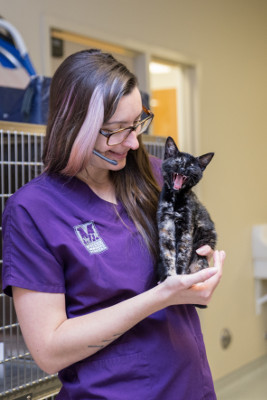Natural Disasters and Pets: Be Prepared
June 7, 2012by Karen S. Phillips, VMD
 Pinching an inch is not a problem just for you and me these days: An increasing number of pets also suffer from weight problems. Carrying extra pounds increases the risk of developing diabetes mellitus, heart disease, urinary tract infections, arthritis and poor grooming habits.
Pinching an inch is not a problem just for you and me these days: An increasing number of pets also suffer from weight problems. Carrying extra pounds increases the risk of developing diabetes mellitus, heart disease, urinary tract infections, arthritis and poor grooming habits.
Is your cat overweight? Feel along the rib cage. If you cannot feel the individual ribs because of a fat layer, your cat is probably carrying extra pounds. Another area where cats carry excess fat is in the hanging “paunch” of their abdomen. Your veterinarian can help you determine whether your cat needs to slim down.
To prevent obesity, play with your cat every day- have it chase a feather on a stick, or use a laser pointer to stimulate a romp. A sprinkle of catnip creates blissful play in many cats, while getting a feline or canine playmate may activate a sedentary cat. Place your cat’s food in a separate room from its sleeping area so your cat must be motivated to eat. Similarly, placing the dish on a counter or shelf will require kitty to expend energy to get its dinner. Also, do not treat your cat to human food.
It is important that everyone in the household cooperates with the weight–loss program- no one should sneak kitty any snacks. Many low-fat, high-fiber, “lite” cat foods are on the market, allowing the same volume of kibble to be eaten without the excess calories. Dividing the daily allotment of food into three or four smaller meals will help kitty feel satisfied throughout the day. If obesity is severe, your veterinarian can prescribe specially formulated diets that are dramatically reduced in calories, yet completely balanced. These can literally be lifesavers.
Feeding A Cat
- Feed prepared food from a reputable manufacturer, two or three small meals a day. Do not overfeed treats or table scraps. Keep dishes clean, toss spoiled food, remove bones from fish and chicken.
- Milk may cause diarrhea; lactose-reduced milk for cats is available.
- Keep fresh water in cat’s bowl at all times.
- Never feed cats chocolate, onions, raw fish, poultry or eggs, bones or food intended for other animals.
- Give nursing mothers extra food. Kittens start sampling canned or moistened dry food at three weeks.
Play
- Good diversions include catnip toys, feathers, fuzzy mice and balls. Activities include hide-and-seek, pulling a mouse or feather on a string.
- Leaving toys unsupervised increases the possibility of a cat swallowing string or yarn.
About The Author
Karen S. Phillips, VMD, is a practicing small-animal veterinarian in Pittsburgh and president of the Western Pennsylvania Veterinary Medical Association. Phillips shares her apartment with three cats: Dorian, Hooti and Par.
